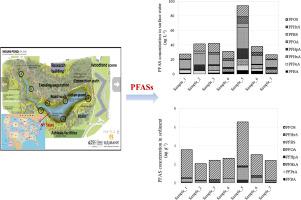Ecological Engineering ( IF 3.9 ) Pub Date : 2021-05-30 , DOI: 10.1016/j.ecoleng.2021.106291 Dongqing Zhang , Xia Li , Mo Wang , Wenyu Xie

|
The occurrence and distribution of poly- and perfluoroalkyl substances (PFASs) in water and sediment cores from a surface flow wetland ecosystem (New York State, USA), as well as their relationships with microbial communities were investigated. The total concentrations of PFASs (∑PFASs) in aqueous phase were in the range of 27.6–94.2 ng L−1, while the values in the sediment varied from 2.1 ng g−1 to 6.6 ng g−1. In the aqueous phase, perfluorooctanoic acid (PFOA) (9.4–28.8 ng L−1) was the most predominant compound, followed by perfluorooctane sulfonic acid (PFOS) (5.8–15.4 ng L−1). PFOS was dominant in sediment, with an average concentration of 2.6 ng g−1, followed by PFOA (0.5 ng g−1) and perfluorohexanesulfonate (PFHxS) (0.1 ng g−1). Sediment-water distribution coefficients (log Kd) were in the range 0.7–2.5, and increased with the increase in perfluoroalkyl chain length. Carbon-chain length was a primary factor governing the distribution and behavior of PFASs in the aquatic environment. A positive correlation between the average log KOC and the chain length of perfluoroalkyl (p < 0.01) was observed. Illumina high-throughput sequencing technology was applied to profile the composition of bacterial community in the sediments. At the phylum level, the predominant (> 1.0%) bacteria included Proteobacteria (63.67%), Armatimonadetes (12.98%), Actinobacteria (9.57%), Bacteroidetes (5.08%), and Verrucomicrobia (1.1%). Variations in microbial communities among sampling stations associated with PFAS concentrations were mainly due to the differences in abundances of Candidatus planktophila, Fluviicola, Methylobacillus, Limnohabitans and Flavobacterium. Results of this study would be beneficial to understanding the distribution and bioaccumulation of PFASs in environmental matrix and provide some useful information for controlling PFASs contaminations in wetland ecosystems.
中文翻译:

表流人工湿地中聚和全氟烷基物质(PFASs)的发生与分布
研究了表面流湿地生态系统(美国纽约州)的水和沉积物核心中聚和全氟烷基物质 (PFAS) 的发生和分布,以及它们与微生物群落的关系。水相中 PFASs (∑PFASs) 的总浓度在 27.6–94.2 ng L -1的范围内,而沉积物中的值从 2.1 ng g -1到 6.6 ng g -1不等。在水相中,全氟辛酸 (PFOA) (9.4–28.8 ng L -1 ) 是最主要的化合物,其次是全氟辛烷磺酸 (PFOS) (5.8–15.4 ng L -1 )。PFOS 在沉积物中占主导地位,平均浓度为 2.6 ng g -1,其次是 PFOA(0.5 ng g-1 ) 和全氟己烷磺酸 (PFHxS) (0.1 ng g -1 )。沉积物-水分配系数(log K d)在 0.7-2.5 的范围内,并且随着全氟烷基链长度的增加而增加。碳链长度是控制 PFAS 在水生环境中分布和行为的主要因素。 观察到平均 log K OC与全氟烷基链长之间呈正相关( p < 0.01)。应用Illumina高通量测序技术分析沉积物中细菌群落的组成。在门水平上,主要 (> 1.0%) 细菌包括变形杆菌(63.67%)、Armatimonadetes(12.98%)、放线菌(9.57%)、拟杆菌(5.08%) 和疣微菌(1.1%)。与全氟和多氟烷基物质浓度相关的采样站之间微生物群落的变化主要是由于浮游梭菌、Fluviicola、甲基杆菌、Limnohabitans 和黄杆菌丰度的差异。本研究结果将有助于了解PFASs在环境基质中的分布和生物积累,并为控制湿地生态系统中PFASs的污染提供一些有用的信息。











































 京公网安备 11010802027423号
京公网安备 11010802027423号